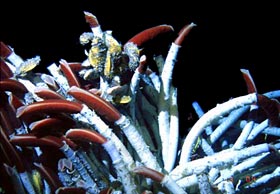For centuries, scientists believed that life was not possible without energy from the Sun. They use to believe that in order for an ecosystem to persist, processes such as photosynthesis had to occur. Photosynthesis is of course driven by the sun's energy and results in plants creating sources of food and energy for other organisms within their ecosystem. This idea that life is impossible without the sun was challenged in 1977 when scientists exploring the ocean floor near the Galapagos Riff, discovered a source massive spikes in the ocean's temperature.
The source later became known as hydrothermal vents. These vents are similar to geysers or hot springs except they exist on the ocean floor. When hot magma rises from mid ocean ridges it cools, forming crusts and volcanic mountain chains. As seawater circulates deep in ocean's crust, it becomes heated by hot magma. As the pressure builds, it begins to dissolve minerals and rise toward the surface of the crust. The hot, mineral-rich waters now leave the oceanic crust and mix with the cool seawater above. Vent structures begin to form as the vent minerals cool and solidify into mineral deposits. Below you will see a brief video of these vents in action.
Hydrothermal vents are capable of emitting hot plumes high in sulfur. Although these emissions are very toxic and have the potential to harm deep sea organisms, hydrothermal vent ecosystems still exhibit great species diversity. This abundance of life is due to the presence of chemoautotrophic bacteria. These bacteria are typically found in giant tube worms (Riftia pachyptila) which are the most common life forms found in vent communities (these worms can grow up to 8 feet long!) These worms and the chemoautotrophic bacteria co-exist in symbiosis or a mutually beneficial relationship. Chemoautotrophs convert the toxic vent materials into usable forms of energy through the process known as chemosynthesis. This process helps provide food for vent organisms, promoting species diversity.
How
organisms are able to survive the extreme conditions of the deep sea
including the toxic environment provided by hydrothermal vents is
quite fascinating. Chemoautotrophic bacteria are an essential feature
of hydrothermal vent ecosystems, providing energy and nutrients to
vent species in the absence of sunlight.
-Posted by Amanda Okpoebo (Group C)
-Posted by Amanda Okpoebo (Group C)

It's so interesting that anything can survive in this type of hostile environment. I heard once that chemoautotrophs were possibly what first gave way to life on earth, and I can imagine that being true considering how they can sustain an entire ecosystem.They truly are amazing little creatures. Great post.
ReplyDeleteErika Nevins
Very interesting post! It’s amazing to see what different kinds of adaptations organisms have developed to survive in such a harsh environment. Perhaps more information on the specific kind of species that co-exist with the hydrothermal vents and the chemoautotrophic bacteria could be provided? Overall great post!
ReplyDelete-Hilary Mello
I like how you included how these vents form in the first place, I never knew that. Very interesting. In the post you said that the sulfur can potentially harm other deep sea organisms, but in the picture it looks like there are a lot of different organisms. Do the surrounding organisms have a similar process for converting sulfur as well?
ReplyDelete-Carolyn McDonagh
Very informative post! I've always been a huge fan of what goes on in the dark zone of the ocean. I never knew though that these vents were actually toxic to the sea life around them. I always thought of them as just being "hot spots" for deep sea life.
ReplyDelete- Mitch
As everyone has said, very interesting and informative post! I was just wondering if you could give a specific example of the relationship between this bacteria and an organism that relies on it and explain exactly how it uses the bacteria to survive?
ReplyDelete-Posted by Ashley Condon
Very cool stuff the depths of the ocean have always intrigued me. Its cool how even in the worst conditions on Earth organisms can harness what their given and prosper. Does this influence how confident you feel about finding life on other planets? Maybe at the bottoms of their oceans or under their icy surfaces their are hot springs that provide life. I also wonder how large of an ecosystem is based off the organisms that obtain their energy from these vents. What do you think about this?
ReplyDelete-Cullan Bartel
I was wondering what are the different kinds of sea organisms that live in the toxic environment?
ReplyDelete-Barbara Afogho